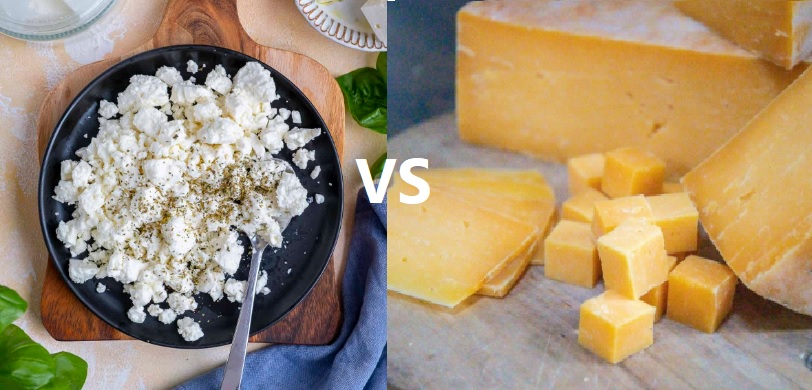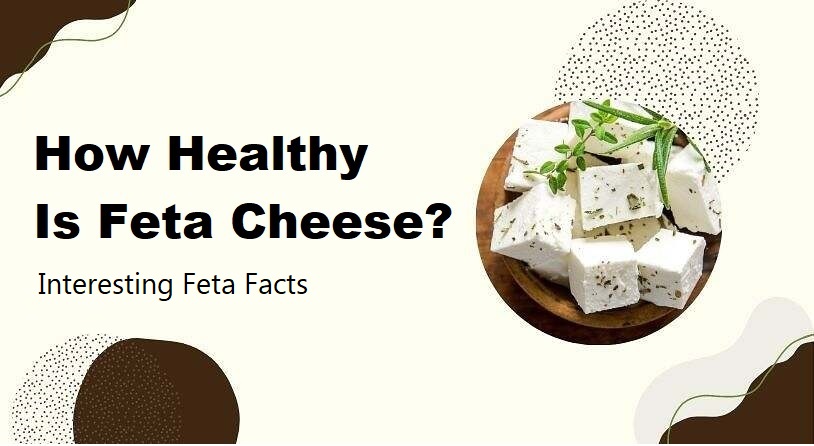How Healthy Is Feta Cheese? Interesting Feta Facts
I love cheese, most of us do. The thing is, when you’re trying to lose weight or stay healthy, having chunks of it whenever you want is not really an option. As a committed cheese lover, I decided to find a healthier alternative when only cheese will do.
That got me thinking…
Have you ever noticed, when eating out, that most salads considered healthy include Feta? So how healthy is feta cheese, and is it a good swap for regular cheese? Read on to find out more.
Contents
What is Feta Cheese?
Traditional feta is a crumbly and delicate cheese soaked in a salted brine. It’s rind less, and when fresh has a sharp, creamy tangy flavor. The more mature feta is the earthier and more pungent it becomes, although it always retains that recognizable sharpness.


This Greek cheese is usually made with sheep’s milk (which gives it its white appearance). However, regulations governed by protected designation of origin or (PDO) allow producers to mix up to 30% sheep’s milk with 30% goat’s milk.
Feta has been around for thousands of years and is used in almost every Greek dish. The word Feta, which translates to “slice,” dates back to the 17th century and is said to point to the technique of slicing up cheese to be stored in barrels, which is still performed today.
See also: How To Easily Get Rid Of A Double Chin (At Home)
is feta a healthy cheese?
To determine this, first, we need to look at its nutrients. As it turns out, feta is packed with goodness. Feta, for example, is rich in:
- calcium
- vitamin B12
- vitamin D
- and amino acids
All the nutrients your body needs. It also contains a lot of vitamins A and K, folic acid, pantothenic acid, iron, and magnesium.
For those watching their waistline, it’s good to know that feta has less fat and calories than, for example, cheddar or Parmesan cheese.
If you were to have 28 grams of cheddar or Parmesan cheese, this would contain more than 110 calories and 7 grams of fat, while feta contains only 74 calories and 6 grams of fat. In addition, this type of cheese has more calcium and B vitamins than, for example, mozzarella, quark, ricotta, or goat cheese.
The nutritional value of feta is:
- Energy 55 kcal
- Fat 4.6 g
- – Of which saturated 3.2 g
- Carbohydrates 0.2 g
- – Of which sugars 0.2
- Fiber 0g
- Protein 4.7g
- Salt 0.3 g
Feta cheese is also beneficial when it comes to …
1. Bone health
Sheep and goat milk have more calcium and phosphorus than cow milk, which is a big plus. The high calcium content of feta means that it’s good for your bones. Not only calcium, but also phosphorus, vitamin B, and proteins, all contribute to bone health and stronger teeth. According to the Nutrition Center, getting enough calcium may help lower your risk of osteoporosis.
2. Good for your gut
Feta is excellent for your gut. It’s particularly high in a certain strain of probiotics called Lactobacillus plantarum, which accounts for approximately 48% of its bacteria. These good bacteria that help to boost your immune system and increase gut health.


For example, L. plantarum has strong adhesive qualities that enable it to “cling” to the gut wall and combat infections like Candida albicans, and pathogenic bacteria such as E-coli and salmonella. Research has also shown that the bacteria offers anti-inflammatory benefits and can help as a probiotic for diarrhea or constipation.
These are some of the reasons many people with irritable bowel syndrome can tolerate feta cheese more than any other cheese.
3. Helps with weight loss
Conjugated linoleic acid (CLA) is an Omega-6 fatty acid present in meat and dairy, particularly grass-fed versions. CLA has been scientifically proven to aid in the reduction of fat mass and the increase of lean body mass. It can also aid in the prevention of diabetes.
The amount of Conjugated linoleic acid (CLA) in cheeses made with sheep’s milk is higher than in cheese produced from cow’s or goat’s milk. Feta cheese contains up to 1.9% CLA, accounting for 0.8% of its total fat content.
As a result, eating feta cheese can help increase your CLA intake and boost fat burning.
Feta is not for everyone
However, not everyone can enjoy this cheese without restrictions. When feta is made, it’s immersed in a brine of approximately seven percent salt. This makes the final product (understandably) high in sodium. If you are sensitive to salt, you should limit the amount of feta you eat. On the occasions you do, rinse it with water first to take off some of that brine.
Also if you are lactose intolerant, this is definitely not the cheese for you. Because feta is an unripened cheese, it actually contains more lactose than your ordinary cheddar.
In addition, it is recommended that pregnant women do not eat unpasteurized dairy products, as they can become contaminated with the listeria monocytogenes bacteria.
Cheeses made with unpasteurized milk, such as feta, have a higher risk of carrying and transmitting this bacteria, which can be harmful to the baby. If you are pregnant, you’re better off avoiding this cheese.
Is feta better for you than cheese?
Well, now that we’ve covered all that, it’s time to answer our initial question. Is feta cheese better than other cheeses? The answer is – it depends. Here’s the comparison between feta cheese and cheddar
- Carbs: feta cheese – 82% more than cheddar
- Calories: cheddar has 55% more calories than Feta
- Fat: cheddar – 57% more than feta cheese


While feta has fewer calories and less fat than cheddar, it is higher in carbohydrates and higher in sodium. In regards to it being higher carbs, this isn’t an issue, as Feta is still fine to eat on a low-carb diet – and you get fewer calories so win-win.
The problem really lies with its salt content. If you actually get too much salt and calories throughout the day, a mountain of feta is not your best choice.
Solutions to this may lie in you washing off the brine, as previously suggested, or adding less salt to your dish overall, so you have a more balanced meal.
Nonetheless, like any other cheese, feta should be eaten in moderation with a balanced and healthy diet.
How do you eat feta?
Feta has a wonderful texture and flavor and can be a good addition to your meals, it’s also quite healthy if eaten in moderation. But what’s the best way to consume this cheese? From starters to desserts: the type of cheese is very versatile. We’ll give you a few ideas:
Combine with fruits
Make a salad with watermelon, feta, and mint. Wonderfully fresh, especially on a hot day.
Through a salad
Prefer something heartier? Crumble a piece of feta over your salad to give it an extra boost of protein and calcium. Usually, you can forgo the creamy dressing for feta, which is better in terms of salt reduction. To keep your salad healthy, go for some olive oil instead.

Grilled on bread
Grill the cheese and drizzle with olive oil, then season with salt and pepper. Delicious with a salad, baguette, or even with pasta.
With pasta
Try this pasta recipe with grilled tomato and baby spinach.
On potatoes
Try crumbling feta on baked potatoes or over a stew with (sweet) potatoes. Omit the salt and add extra vegetables, and your meal with feta is very healthy!











